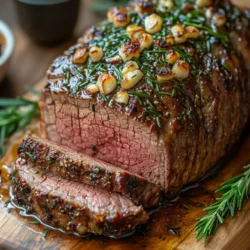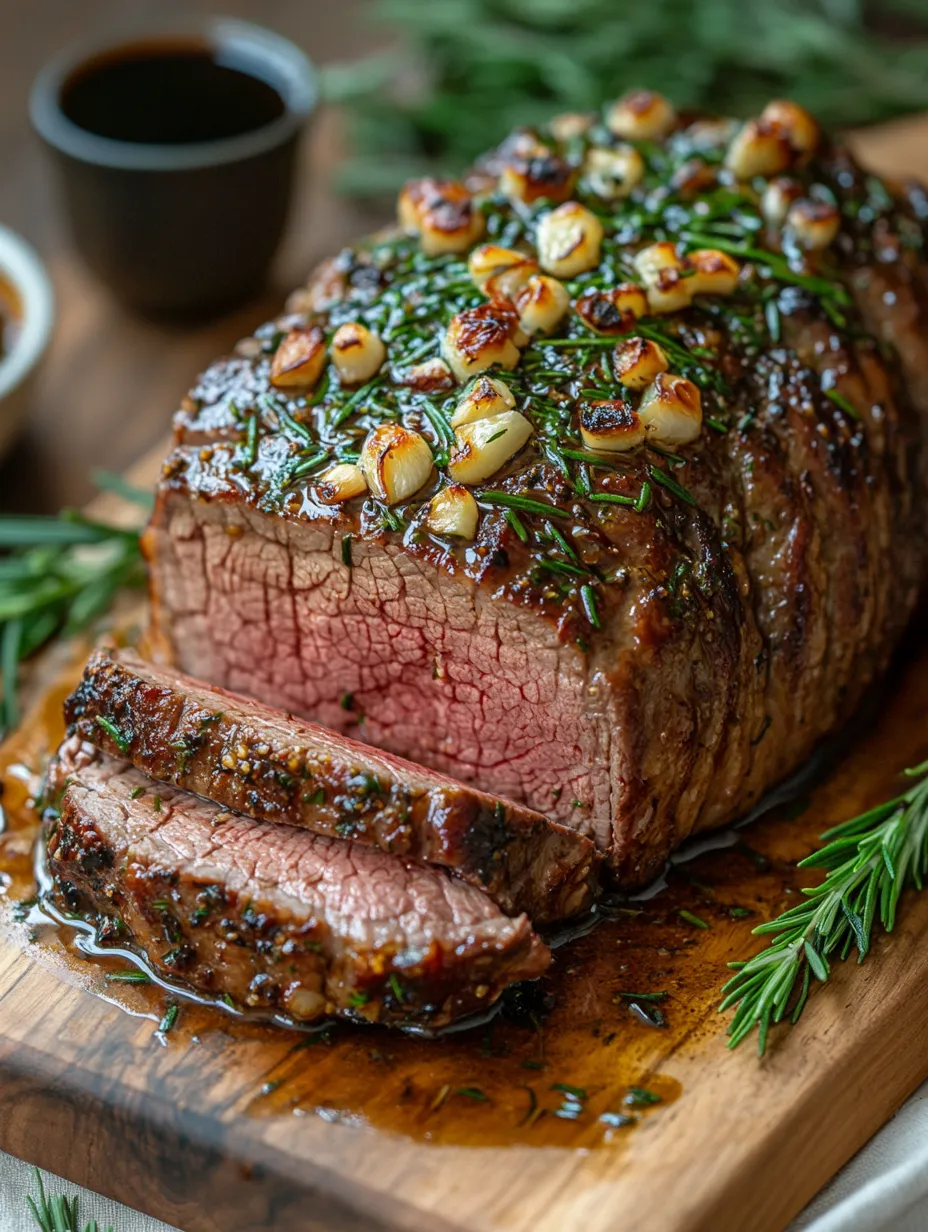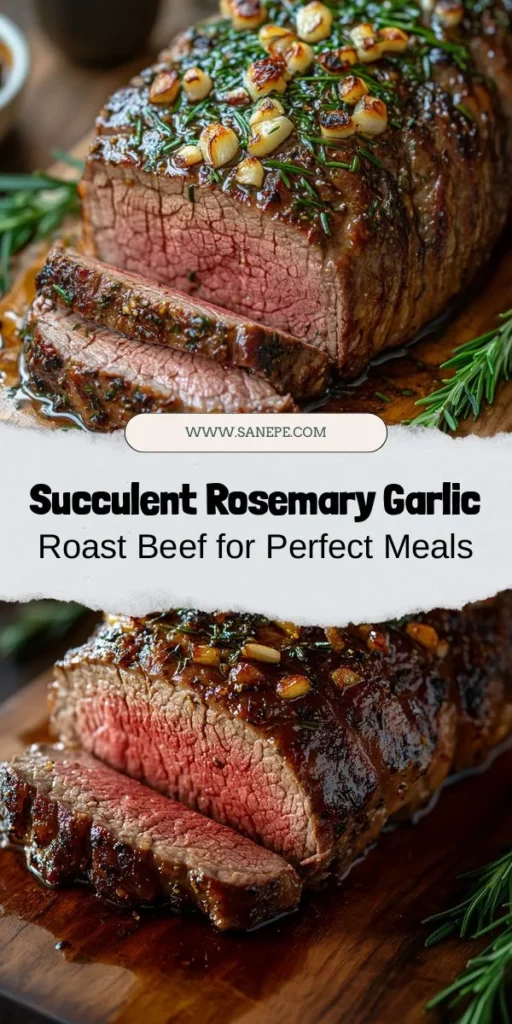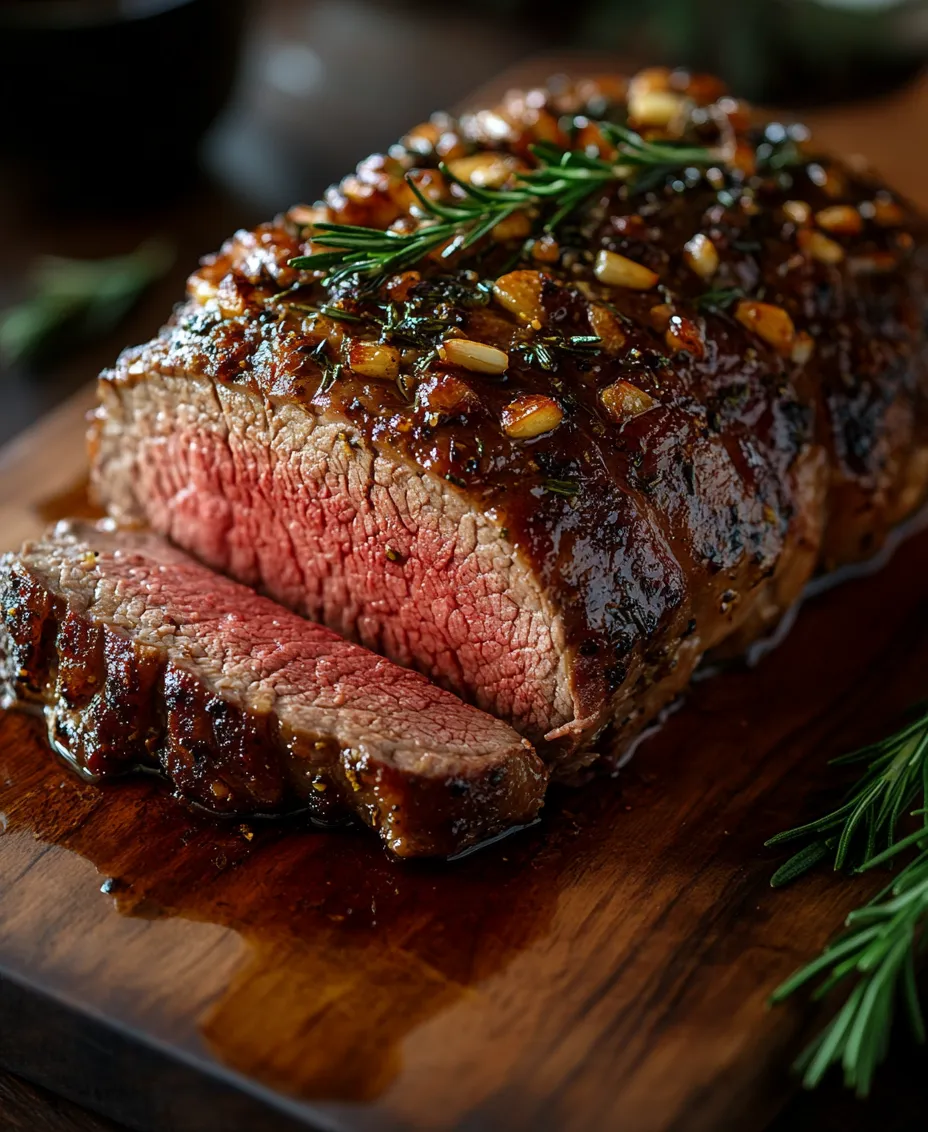Introduction
When it comes to classic comfort food, few dishes can rival the hearty, mouthwatering experience of Rosemary & Garlic Roast Beef. This timeless recipe is not just a meal; it’s an experience steeped in tradition, perfect for family gatherings, Sunday dinners, or special occasions. The savory aroma that fills your kitchen as this succulent roast cooks is enough to make anyone’s mouth water, igniting fond memories and creating new ones around the dinner table.
One of the most important aspects of preparing an exceptional roast beef is the quality of the ingredients used. Selecting the right cut of beef and incorporating fresh herbs can dramatically elevate the flavor profile of the dish. Fresh rosemary and robust garlic work harmoniously to infuse the meat with rich, aromatic flavors, making each bite a delightful experience. This article aims to provide a comprehensive guide to preparing this delicious Rosemary & Garlic Roast Beef recipe, ensuring that even novice cooks can achieve a tender and flavorful result that will impress family and friends alike.
Understanding the Key Ingredients
Before diving into the preparation of this succulent roast beef, it’s essential to understand the key ingredients that contribute to its delicious flavor and texture.
Discussion on Beef Roast Types
Choosing the right cut of beef is crucial for achieving the best results in your roast. The two most popular cuts for roasting are chuck and ribeye, each offering unique flavor profiles and characteristics.
Chuck Roast
Chuck roast is a well-marbled cut that comes from the shoulder of the cow. Its higher fat content makes it an excellent choice for slow roasting, as it becomes incredibly tender and flavorful when cooked properly. The marbling within the meat breaks down during the cooking process, resulting in a juicy and rich roast that is perfect for hearty meals.
Ribeye Roast
On the other hand, the ribeye roast is renowned for its tenderness and rich flavor. This cut comes from the rib section and is known for its significant marbling, which imparts a buttery texture. Although ribeye is often more expensive than chuck, it yields a succulent roast that is ideal for special occasions.
The Role of Garlic and Rosemary
Garlic and rosemary are not just complementary ingredients; they are the stars of this roast beef recipe. Both ingredients enhance the flavor of the meat while also providing numerous nutritional benefits.
Nutritional Benefits and Flavor Contributions of Garlic
Garlic is not only a flavor powerhouse but also comes with a host of health benefits. Rich in antioxidants and vitamins, garlic can help boost the immune system and lower blood pressure. Its pungent aroma and distinctive flavor infuse the roast with a depth that enhances the overall eating experience. When roasted, garlic becomes sweet and mellow, creating a delightful contrast to the savory beef.
How Fresh Rosemary Complements the Beef
Fresh rosemary adds an aromatic quality to the roast, with its needle-like leaves releasing essential oils that enhance the dish’s flavor. This herb is known for its earthy and slightly piney taste, which pairs beautifully with beef. Not only does rosemary elevate the flavor profile, but it also adds a touch of elegance to the dish, making it visually appealing when plated.
Importance of Seasoning
To truly bring out the flavors of the beef and herbs, proper seasoning is essential. The impact of sea salt and black pepper cannot be overstated.
– Sea Salt: Enhances the natural flavors of the meat, drawing out moisture and creating a delicious crust when roasted.
– Black Pepper: Adds a subtle heat and depth that complements the richness of the beef, providing a well-rounded flavor experience.
By using quality ingredients and careful seasoning, you can elevate your Rosemary & Garlic Roast Beef from ordinary to extraordinary.
Preparation Steps for a Perfect Roast
Before you begin cooking, it’s essential to prepare your kitchen and ingredients. Organization and preparation are key to a successful roast.
Prepping the Kitchen and Ingredients
Start by gathering all the ingredients you will need, including your chosen cut of beef, fresh rosemary, garlic, sea salt, black pepper, and any additional ingredients specified in your recipe. Ensure you have all necessary equipment ready, such as a roasting pan, a sharp knife, and a cutting board.
Cleaning your workspace and organizing your ingredients will make the cooking process smoother and more enjoyable. This preparation step is particularly important for novice cooks who may feel overwhelmed in the kitchen.
The Marinade Process
Once your ingredients are organized, it’s time to prepare the marinade. Marinating the beef is a crucial step for flavor infusion and tenderness.
Why Marinating is Crucial for Flavor Infusion and Tenderness
Marinating allows the flavors of the garlic and rosemary to penetrate the meat, ensuring that every bite is packed with taste. Additionally, the marinade can help break down the proteins in the beef, resulting in a more tender roast.
Tips on Marinating Time and Techniques for Optimal Results
– Timing: Ideally, you should marinate your beef for at least 4 hours, but overnight marination is recommended for maximum flavor. This allows the garlic and rosemary to fully infuse into the meat.
– Technique: Combine minced garlic, chopped rosemary, sea salt, and black pepper with olive oil to create a paste. Rub this mixture all over the beef, ensuring it is evenly coated. For added flavor, consider placing some of the marinade inside any crevices in the meat.
By taking the time to marinate, you set the stage for a beautifully flavored and tender roast.
Searing the Roast: The Key to Flavor
Once your beef has marinated, the next step is to sear it. This is a critical process that will lock in the juices and enhance the flavor of your Rosemary & Garlic Roast Beef.
Explanation of the Searing Process
Searing involves cooking the surface of the meat at a high temperature until a brown crust forms. This process not only adds a rich flavor to the roast but also helps seal in the moisture, ensuring that your beef remains juicy and tender throughout the cooking process.
Tips for Achieving the Perfect Sear
To achieve the perfect sear, follow these tips:
– Equipment Needed: Use a heavy skillet, preferably cast iron or stainless steel, as these materials retain heat exceptionally well and promote even browning.
– Temperature Control: Preheat your skillet over medium-high heat. Ensure it is hot enough before adding the beef; a drop of water should sizzle immediately upon contact with the pan.
Once the skillet is adequately heated, place the marinated roast in the pan without overcrowding. Let it sear for several minutes on each side until a golden-brown crust forms. This step is essential for building depth of flavor in your roast, making it an integral part of the cooking process.
By understanding the importance of each ingredient and preparation step, you are well on your way to creating a Rosemary & Garlic Roast Beef that is not only flavorful but also a tender delight. Stay tuned as we dive deeper into the cooking process and finalize the steps to achieving this culinary masterpiece.
Roasting Techniques for Ideal Doneness
When it comes to roasting beef, achieving the perfect doneness is essential for a flavorful and satisfying meal. The key lies not only in the seasoning but also in the specific techniques employed during the cooking process.
Setting the Oven Temperature
For optimal roasting, it’s crucial to preheat your oven to the right temperature. The ideal temperature for roasting beef is 325°F (163°C). This moderate heat allows the roast to cook evenly throughout, ensuring that the outside develops a beautiful crust while the inside remains juicy and tender. While higher temperatures might seem tempting for a quicker cooking time, they can lead to uneven doneness and a dry exterior.
Why 325°F is Ideal for Roasting Beef
Roasting at 325°F provides a sweet spot where the meat can gradually cook, allowing enzymes to break down the connective tissues, resulting in a more tender roast. This low and slow method is particularly beneficial for tougher cuts of beef, which require longer cooking times to reach their full potential. Cooking at this temperature also allows for better flavor development as the herbs and spices meld with the meat.
Understanding Cooking Times and Meat Thermometers
Cooking times can vary based on the size and cut of your roast. A general rule of thumb is to allow approximately 20 minutes per pound for medium-rare beef, but using a meat thermometer is the most reliable way to ensure perfect doneness. Insert the thermometer into the thickest part of the roast, avoiding any bones or fat. Here are the internal temperature guidelines for various levels of doneness:
– Rare: 125°F (52°C)
– Medium-rare: 135°F (57°C)
– Medium: 145°F (63°C)
– Medium-well: 150°F (66°C)
– Well done: 160°F (71°C)
How to Check for Doneness: Medium-Rare vs. Medium
For a classic roast beef, many prefer the medium-rare doneness, which offers a warm red center and maximum juiciness. To achieve this, aim for an internal temperature of around 135°F. If you favor a more cooked roast, medium, which reaches 145°F, is also a great option, providing a pinkish center and slightly firmer texture. Regardless of your preference, always remember to remove the roast from the oven when it is about 5°F below your target temperature, as the meat will continue to cook while resting.
Importance of Resting the Meat
Once you have successfully roasted your beef, the next crucial step is resting. Allow the roast to rest for at least 15-20 minutes before carving. This resting period is vital as it allows the juices to redistribute throughout the meat. Cutting into the roast too soon can cause these flavorful juices to run out, resulting in a dry roast.
Explanation of How Resting Enhances Juiciness and Tenderness
Resting enhances both juiciness and tenderness by allowing the muscle fibers to relax and reabsorb the juices. As the temperature stabilizes, the meat continues to cook slightly from residual heat, further enhancing its tenderness. For maximum flavor, cover the roast loosely with aluminum foil during this time to keep it warm without trapping moisture, which could lead to steaming.
Creating the Gravy: Elevating Your Meal
No roast beef dinner is complete without a rich, savory gravy. Making gravy from the drippings left in the roasting pan is not only simple but also elevates your meal to new heights.
Overview of the Gravy-Making Process
To begin, once your roast is resting, place the roasting pan on the stove over medium heat. The drippings will be packed with flavor, so it’s essential to utilize them for your gravy. If there is an excessive amount of fat, you may want to skim off some of it, leaving about 2-3 tablespoons in the pan.
How to Utilize Leftover Drippings for a Rich Sauce
Add about 1/4 cup of all-purpose flour to the drippings, stirring constantly to form a roux. Cook the mixture for about 2-3 minutes until it turns a golden brown color. This step removes the raw flour taste and helps to thicken the gravy. Gradually add 3-4 cups of beef broth or stock, whisking continuously to prevent lumps. Bring the mixture to a simmer, allowing it to thicken to your desired consistency.
Tips for Thickening and Seasoning the Gravy
If your gravy is too thin, continue simmering until it thickens further. For a thicker gravy, you can create a slurry by mixing equal parts flour or cornstarch with cold water, then whisking it into the simmering gravy. Season your gravy with salt and pepper, and consider adding a splash of Worcestershire sauce or a teaspoon of Dijon mustard for an extra layer of flavor. Taste and adjust the seasoning as needed.
Adjusting Flavors and Consistency to Personal Preference
Everyone has their own preference for gravy, so don’t hesitate to experiment. If you prefer a smoother texture, strain the gravy through a fine-mesh sieve before serving. For a more robust flavor, consider adding sautéed onions, garlic, or even a splash of red wine to the drippings before thickening. These additions can transform your gravy into a truly gourmet accompaniment.
Serving Suggestions and Pairings
Now that your Rosemary & Garlic Roast Beef is complete, it’s time to think about the perfect sides to complement your meal.
Ideal Sides to Complement the Roast Beef
Roast beef pairs beautifully with a variety of sides. Classic choices include mashed potatoes, which can be elevated with garlic or cream for added richness, and roasted vegetables such as carrots, Brussels sprouts, or green beans, which add color and nutrition to your plate. For a lighter option, consider a fresh garden salad dressed with a tangy vinaigrette to balance the richness of the beef.
Suggestions for Vegetables, Starches, and Salads that Enhance the Meal
Starches like Yorkshire pudding or crispy roasted potatoes are traditional favorites that capture the essence of a hearty roast dinner. For vegetables, try a medley of seasonal roasted root vegetables, drizzled with olive oil and herbs. A refreshing cucumber salad can offer a crisp contrast to the savory flavors of the roast.
Presentation Tips
When it comes to serving, presentation matters. Slice the roast against the grain for maximum tenderness, and arrange the slices on a large platter. Garnish with fresh herbs like rosemary or thyme for a pop of color and aroma. Serve the gravy in a separate sauce boat or drizzle it over the meat for an appealing look.
How to Slice and Plate the Roast for an Appealing Presentation
For an elegant touch, consider plating individual portions. Arrange a few slices of roast on each plate alongside a generous spoonful of gravy, a serving of mashed potatoes, and a colorful selection of vegetables. A sprinkle of fresh herbs or a dusting of black pepper can add the finishing touch.
Nutritional Information and Benefits
Understanding the nutritional content of your meal can enhance your cooking experience. A typical serving of Rosemary & Garlic Roast Beef (approximately 3 ounces) contains:
– Calories: 250
– Protein: 30 grams
– Fat: 15 grams
– Iron: 2.5 mg (15% of daily value)
– Vitamin B12: 2 μg (33% of daily value)
– Zinc: 5 mg (45% of daily value)
Highlighting Protein, Vitamins, and Minerals
Beef is an excellent source of high-quality protein, which is essential for muscle growth and repair. It is also rich in essential vitamins and minerals, particularly B vitamins such as B12 and niacin, which play crucial roles in energy metabolism and red blood cell formation. The iron content in beef helps support healthy oxygen transport in the body, making it an excellent choice for individuals needing to boost their iron intake.
Discussing the Balance of Flavors and Health Benefits of the Ingredients
The addition of rosemary and garlic not only enhances the flavor profile of the roast but also offers health benefits. Rosemary is rich in antioxidants and has anti-inflammatory properties, while garlic is known for its immune-boosting effects. Using fresh herbs and aromatics in your cooking can contribute to overall health while making your meals more satisfying.
Conclusion
The Rosemary & Garlic Roast Beef recipe is a timeless classic that captures the essence of home-cooked comfort. With its fragrant herbs, tender meat, and rich gravy, this dish is perfect for family gatherings or special occasions.
Cooking and sharing a homemade meal brings joy and connection, making it a cherished experience for you and your loved ones. We hope this recipe inspires you to try your hand at roasting beef and that you enjoy the process as much as the delicious results. Embrace the art of cooking and create lasting memories around the dinner table with this delightful roast beef dish. Enjoy!



